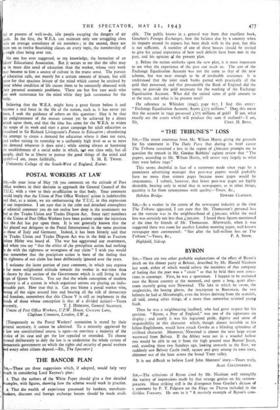THE BANCOR PLAN
Sta,—There are three suggestions which, if adopted, would help very uch in considering Lord Keynes's plan: 1. That the authors of the White Paper ,should give a few detailed =pies, with figures, showing how the scheme would work in practice.
2. That the wealth of experience possessed by bankers, merchant- nkers, discount and foreign exchange houses should- be made avail- able. The public knows in a general way from that excellent book, Goschen's Foreign Exchanges, .how the balance due by a country when its imports exceed its exports has been dealt with in the past, but this is not sufficient. A member of one of these houses should be invited to give his actual experience of how such deficits have been met in the past, and his opinion of the present plan.
3. Before the nation embarks upon the new plan, it is most important to see what the experience of the past can teach us. The atm of the Exchange Equalisation Account -was not the same as that of the new scheme, but was near enough to be of invaluable assistance. It is understood that the joint stock banks parted with practically all the gold they possessed, and that presumably the Bank of England did the same, to provide the gold necessary for the working of the Exchange Equalisation Account. What did the united sums of gold amount to at the start, and what is its present total?
On reference to Whitaker (1942), page 617, I find this entry: "Exchange Equalisation Account, Assets £575 millions." Does this mean that the account in 1942 possessed £575 millions of gold? If not, what exactly are the assets which will produce this sum if realised?—I am,


























 Previous page
Previous page